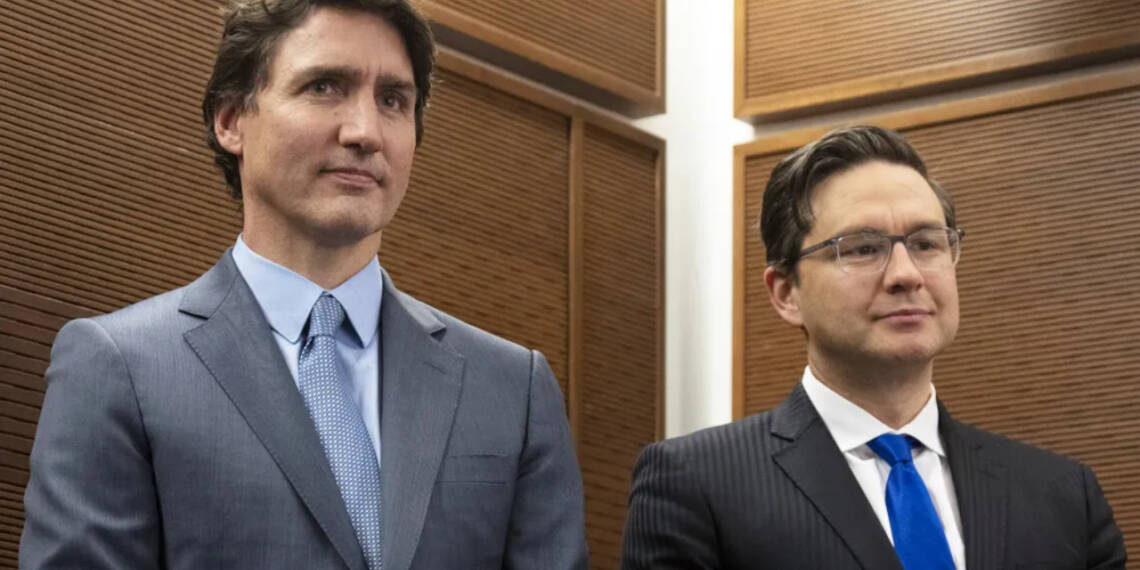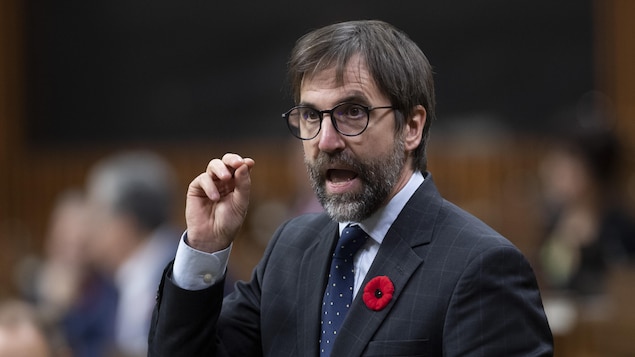Hey, political buffs! Trudeau vs. Poilievre showdown—got questions? Here’s a quickfire round to get the scoop! Why’s Trudeau drawing lines in the political sand? Effective or just preaching to the choir?Poilievre’s ads buzzing since summer—where’s the liberal buzz? Are Liberals fashionably late to the strategic ad party?
Abacus polls ring the alarm for Trudeau. Can they reverse the trend, or is Poilievre’s momentum too much?
In the ever-evolving political landscape of Canada, the battle lines are drawn between Justin Trudeau’s Liberals and the Conservatives, led by Pierre Poilievre. In recent times, Justin Trudeau and his Liberals have been increasingly using their public announcements to draw a sharp line between themselves and the Conservatives.
On Tuesday, Environment Minister Steven Guilbeault responded to environmental commissioner criticism, emphasising the Liberal commitment to a climate plan. This move, however, raises questions about the effectiveness of such tactics in reaching a broader audience.
Read More: Trudeau is running away from Poilievre like a dog
From a strictly partisan standpoint, it might seem logical. Liberals often appreciate hearing fellow Liberals criticize Conservative Leader Pierre Poilievre, emphasizing the potential negative outcomes if he were to assume power. However, the effectiveness of this strategy is limited when it comes to reaching a broader audience. Such remarks are typically treated by the media as throwaway lines, seldom finding a place in their reports.
This prompts a couple of questions. If Liberals are genuinely committed to highlighting the sharp contrast between themselves and Poilievre, why not take the decisive step of launching a comprehensive ad campaign to clearly delineate those differences? Poilievre has already invested in ads that have been consistently present on the airwaves since the summer. The question arises: where is the equivalent effort from the Liberals?
David Herle, a seasoned Liberal strategist, expressed his bafflement on the lack of strategic action, suggesting a potential impact on the party’s comeback hopes.
“I have been saying for a year that they should be framing Poilievre. It’s not too late, but it’s getting too late,” says David Herle.
The recent Abacus Data polling results reveal a significant challenge for Trudeau. Poilievre is gaining momentum, with over half of 2021 Liberal voters considering a switch if uncomfortable with him as prime minister.
While a contrast ad featuring Poilievre alongside Donald Trump has circulated on social media, its absence from mainstream channels raises questions about its reach and impact.
Drawing parallels to U.S. politics, where President Biden faced a similar scenario, the effectiveness of positive campaigning is questioned. The need to frame the race as a choice, rather than a referendum, is emphasized by Democratic figures, raising concerns about the $7 million spent on positive ads.
Trudeau’s aversion to negative campaigning, stemming from his experiences with Conservative attack ads, may explain the current void in Liberal advertising. However, this raises the question of whether financial constraints are hindering their ability to counter Poilievre’s dominance.
Simultaneously, an uprising wave of anti-Trudeau sentiment is evident on social media, with campaigns like #TrudeauMustResign gaining traction. Petitions demanding Trudeau’s resignation have garnered significant support, reflecting a growing dissatisfaction with his policies.
Canadians are speaking up, demanding change. The sentiment, encapsulated in statements like ‘Tell Trudeau to resign and call an election now,’ signals a shift in public perception and a potential threat to Trudeau’s political standing.

The discontent with Trudeau’s policies is not confined to social media campaigns. Recent developments reveal a growing dissatisfaction, highlighted by petitions such as #TrudeauMustResign. The numbers speak volumes, with the petition now boasting 144,222 signatures, up from 142,502 just yesterday. Clearly, Canadians are expressing a desire for change, signaling that Trudeau’s policies may no longer resonate with the electorate.
Read More: The Manifesto of the next Canadian PM looks pretty promising
As calls for Trudeau’s resignation gain momentum, the Liberal response appears to be lacking. The party’s reluctance to counter Poilievre’s dominance through a robust advertising campaign has left many strategists, including David Herle, bewildered. The strategic importance of framing Poilievre is underscored, with potential Liberal voters indicating a willingness to return to the fold if uncomfortable with him as prime minister.
Interestingly, as we dissect the dynamics of Canadian politics, parallels can be drawn to the challenges faced by U.S. President Joe Biden. A recent New York Times/Siena poll revealed discouraging findings, showing Biden trailing behind Trump in key battleground states. The situation is not entirely dissimilar to the Abacus Data poll, which indicates Poilievre’s edge over Trudeau on crucial matters such as the economy and foreign policy.
In the face of these challenges, the question arises: how will Trudeau’s team navigate this complex political landscape? The reluctance to engage in a comprehensive ad campaign raises speculation about the reasons behind this decision. While Trudeau’s aversion to negative campaigning is well-known, strategists like Herle suggest that the urgency of framing the next election as a stark choice cannot be overstated.
As Canada stands at a crossroads, with elections on the horizon, Trudeau’s Liberals find themselves at a critical juncture. The challenge from Poilievre, coupled with a groundswell of discontent, paints a complex picture. Will Trudeau’s team shift gears and effectively communicate their vision to the electorate, or will the tide continue to turn in favor of the Conservatives? Only time will tell.
Watch More:
https://youtu.be/otNr-Ez7e4A?si=gUC_J17-rOp8Rzkx









